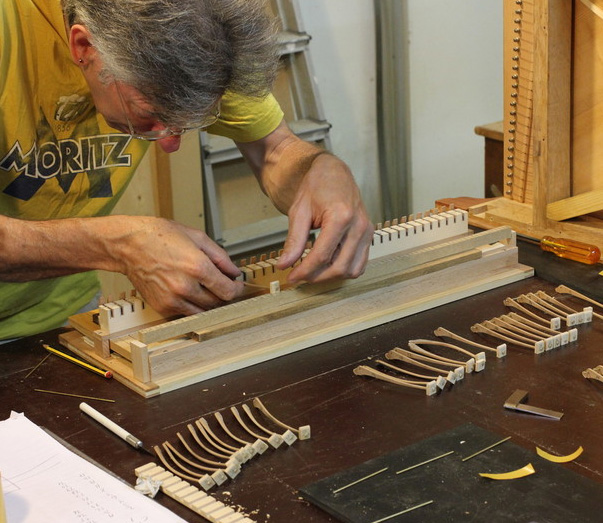Ample iconographic and literary evidence exist to demonstrate that small strung keyboard instruments were very popular in the 15th and 16th century

Ample iconographic evidence exists to demonstrate that small strung medieval keyboard instruments were quite common. A number of surviving texts either state or imply that one manner of exciting these strings was by striking them with some kind of hammer mechanism. Chief among these sources is Arnaut de Zwolle’s well-known manuscript with its amazing drawings, which describes a number of different instrument layouts as well three different plucking actions and a simplistic hammered action. Arnaut’s text has provided a great source of inspiration for modern makers wishing to recreate such instruments, due to its relatively high degree of detail. However, precisely because it is the only such source, his solitary vision has also – some believe – acted as a conceptual straightjacket, essentially discouraging any serious consideration of credible alternatives.
For the last ten years David Catalunya’s contribution to organologic research and his exploration of performance techniques specific to the late-medieval keyboard instruments have placed him as an artist of reference in the field of this pre-Renaissance music.
The hammered clavisimbalum (2012) is the most recent and innovative project carried out by the Spanish musician, David Catalunya in collaboration with Paul Poletti. The result has been a formidable instrument able to perform an extraordinary wide range of dynamics and expressive possibilities and a completely revamped approach to the 15th century keyboard repertoire. This “mechanized psaltery”, as the historical sources describe it, has a brilliant and powerful sound and allows the performer to deal with the most virtuoso music of the period.
One repertoire currently being explored is the keyboard music at the court of Henry VIII. Himself an accomplished composer, his court was filled with an extensive range of different musicians – lute-players, trumpeters, drummers, wind- and string-players plus singers galore as well as masters of the different keyboards. In 1516 some of the most prominent keyboard players in Europe were added: Benedictus de Opicijs from Antwerp and Dionysius Memo; both were allowed into the kings private chambers. Later the Englishmen John Haywood and Simon Burton took their places.
The music, which has been preserved, is currently being studied and performed in the context of Tasto Solo together with Guillermo Perez, who is leader of the ensemble famous for its performance of repertoires from the 14th and 15th centuries using this new instrument.
SOURCE:
KEYES & MUSYKS – Henry VIII keyboard repertoire, 1500-1550
READ MORE:
The story of the most recent reconstruction of the clavisimbalum carried through by David Catalunya and Paul Poletti may be read here:
Late Medieval Strung Keyboard Instruments: New Reflections and Attempts at Reconstruction
By: David Catalunya and Paul Poletti
In: Journal of the Alamire Foundation, Volume 4, Number 1 – 2012, 141-155
DOI 10.1484/J.JAF.1.102611 – ISSN 2032-5371 (Print)
Recreating the Clavisimbalum of the Minden Cathedral Alterpiece
By Tom Strange
Paper presented at the Historical Keyboard Society 2012
